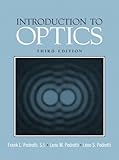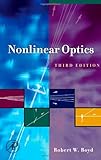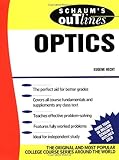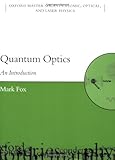|
|
Help |
| Home - Science - Optics (Books) | |
e99 Online Shopping Mall
|
|
Help |
| Home - Science - Optics (Books) | |
| 1-20 of 100 | Next 20 |
click price to see details click image to enlarge click link to go to the store
| 1. Introduction to Modern Optics by Grant R. Fowles | |
 | Paperback: 336
Pages
(1989-06-01)
list price: US$16.95 -- used & new: US$9.96 (price subject to change: see help) Asin: 0486659577 Average Customer Review: Canada | United Kingdom | Germany | France | Japan |
|
Editorial Review Product Description Customer Reviews (11)
| |
| 2. Optics (4th Edition) by Eugene Hecht | |
 | Hardcover: 680
Pages
(2001-08-12)
list price: US$148.20 -- used & new: US$114.98 (price subject to change: see help) Asin: 0805385665 Average Customer Review: Canada | United Kingdom | Germany | France | Japan |
|
Editorial Review Product Description Customer Reviews (37)
| |
| 3. Introduction to Fourier Optics by Joseph W. Goodman | |
 | Hardcover: 491
Pages
(2004-12-10)
list price: US$98.50 -- used & new: US$60.91 (price subject to change: see help) Asin: 0974707724 Average Customer Review: Canada | United Kingdom | Germany | France | Japan |
|
Editorial Review Product Description Customer Reviews (11)
| |
| 4. FOA Reference Guide to Fiber Optics: Study Guide to FOA Certification by Jim Hayes | |
 | Paperback: 192
Pages
(2009-09-04)
list price: US$24.95 -- used & new: US$21.56 (price subject to change: see help) Asin: 1439253870 Average Customer Review: Canada | United Kingdom | Germany | France | Japan |
|
Editorial Review Product Description Customer Reviews (2)
| |
| 5. Introduction to Optics (3rd Edition) by Frank L Pedrotti, Leno M Pedrotti, Leno S Pedrotti | |
 | Hardcover: 656
Pages
(2006-04-17)
list price: US$149.80 -- used & new: US$115.06 (price subject to change: see help) Asin: 0131499335 Average Customer Review: Canada | United Kingdom | Germany | France | Japan |
|
Editorial Review Product Description Comprehensive and fully updated, this reader-friendly introduction to optics provides clear, concise derivations and explanations of optical phenomena, avoiding extraneous material. Updates material related to laser systems. Updated chapters on Optical Interferometery, Fiber Optics, and Holography. Introduces a broad range of new applications throughout, including liquid crystal displays, CCD's, CD and DVD Technology. Features a more intensive exploration of communication systems than in previous editions. Provides approximately 50 new problems and 50 new or revised figures. A general reference for optical industry practitioners. Customer Reviews (8)
| |
| 6. Nonlinear Optics, Third Edition by Robert W. Boyd | |
 | Hardcover: 640
Pages
(2008-04-11)
list price: US$104.00 -- used & new: US$47.18 (price subject to change: see help) Asin: 0123694701 Average Customer Review: Canada | United Kingdom | Germany | France | Japan |
|
Editorial Review Product Description Customer Reviews (14)
| |
| 7. Schaum's Outline of Optics by Eugene Hecht | |
 | Paperback: 256
Pages
(1974-11-01)
list price: US$19.95 -- used & new: US$12.70 (price subject to change: see help) Asin: 0070277303 Average Customer Review: Canada | United Kingdom | Germany | France | Japan |
|
Editorial Review Product Description Customer Reviews (8)
| |
| 8. The FOA Reference Guide to Outside Plant Fiber Optics by Jim Hayes | |
 | Paperback: 260
Pages
(2010-06-30)
list price: US$27.95 -- used & new: US$27.95 (price subject to change: see help) Asin: 1450559670 Canada | United Kingdom | Germany | France | Japan |
|
Editorial Review Product Description | |
| 9. Principles of Optics: Electromagnetic Theory of Propagation, Interference and Diffraction of Light (7th Edition) by Max Born, Emil Wolf | |
 | Hardcover: 986
Pages
(1999-10-13)
list price: US$98.00 -- used & new: US$59.62 (price subject to change: see help) Asin: 0521642221 Average Customer Review: Canada | United Kingdom | Germany | France | Japan |
|
Editorial Review Product Description Customer Reviews (10)
However, it is hard to read and use a weird notation. Certainly not useful for rapid referencing. Like the bible, use it only when you have serious problem to deal with. ... Read more | |
| 10. Quantum Optics: An Introduction (Oxford Master Series in Physics, 6) by Mark Fox | |
 | Paperback: 400
Pages
(2006-06-22)
list price: US$65.00 -- used & new: US$37.69 (price subject to change: see help) Asin: 0198566735 Average Customer Review: Canada | United Kingdom | Germany | France | Japan |
|
Editorial Review Product Description Customer Reviews (5)
| |
| 11. Fiber Optic Reference Guide, Third Edition by David Goff | |
 | Paperback: 260
Pages
(2002-03-29)
list price: US$69.95 -- used & new: US$61.13 (price subject to change: see help) Asin: 0240804864 Average Customer Review: Canada | United Kingdom | Germany | France | Japan |
|
Editorial Review Product Description Customer Reviews (4)
The book was laid out logically, and did a good job of building on knowledge explained in previous chapters.There were one page summaries at the tale of each chapter, which were helpful in allowing you to either skip or skim the text. The glossary at the end of the book was especially useful, as was the end chapter on future trends within the industry.The book was a quick read, and once I had finished it I felt comfortable engaging in a discussion with people much more accomplished in the field than myself. ... Read more | |
| 12. Last-Minute Optics: A Concise Review of Optics, Refraction, and Contact Lenses by David G. Hunter PhDMD, Constance E. West MD | |
 | Paperback: 144
Pages
(2010-04-15)
list price: US$47.95 -- used & new: US$41.81 (price subject to change: see help) Asin: 1556429274 Average Customer Review: Canada | United Kingdom | Germany | France | Japan |
|
Editorial Review Product Description The popular optics review manual, Last-Minute Optics: A Concise Review of Optics, Refraction, and Contact Lenses, has been revised and updated into a Second Edition. This unique resource boils down the overwhelming subject matter of clinical optics and refraction, helping the ophthalmologist cover the essentials in a single review manual. The content is based upon the practical experience of two clinically active experts who lecture on ophthalmic optics around the world. This updated Second Edition by Drs. David G. Hunter and Constance E. West includes new questions added to selected chapters and a new chapter covering refractive surgery, as well as a key chapter that helps you evaluate patients with symptoms related directly to optical or refractive concerns. The complex concepts of optics are revealed in easy-to-understand explanations enhanced by simple illustrations. Last-Minute Optics, Second Edition allows you to test your knowledge while increasing your understanding of optics. Designed in a clear, concise, question-and-answer format, this book allows for self-assessment and a chance to test your understanding before you read the answer. Features of the Second Edition: • Written in a light and approachable style to make optics accessible and understandable Whether you’re an ophthalmologist, ophthalmic technician, resident or student, reviewing the optics facts and concepts is easier with Last-Minute Optics: A Concise Review of Optics, Refraction, and Contact Lenses, Second Edition. Customer Reviews (4)
As alearning tool it is also lacking, with little detail or helpfuldiagrams. However, as a study tool, this review should serve the student well if he/she had a real reference from which to learn.That is, in fact, what it markets itself to be -- a last minute study review -- so no false advertising here. Kirk Carver, Patient Advocate,... ... Read more | |
| 13. Introduction to Quantum Optics: From the Semi-classical Approach to Quantized Light by Gilbert Grynberg, Alain Aspect, Claude Fabre | |
 | Hardcover: 696
Pages
(2010-10-18)
list price: US$80.00 -- used & new: US$70.13 (price subject to change: see help) Asin: 0521551129 Canada | United Kingdom | Germany | France | Japan |
|
Editorial Review Product Description | |
| 14. Optics Demystified by Stan Gibilisco | |
 | Paperback: 368
Pages
(2009-06-22)
list price: US$24.95 -- used & new: US$14.19 (price subject to change: see help) Asin: 0071494499 Average Customer Review: Canada | United Kingdom | Germany | France | Japan |
|
Editorial Review Product Description An enlightening guide to optics Are you in the dark when it comes to understanding the science of optics? Now there's a glimmer in the gloom! Optics Demystified brings this challenging topic into focus. Written in an easy-to-follow format, this practical guide begins by covering the nature of light, the electromagnetic spectrum, reflection, refraction, and color dispersion. You'll move on to common optical devices and effects, lasers, and optical data transmission technology. Industrial, medical, and military applications are discussed, as are exotic optics such as holography. Detailed examples and concise explanations make it easy to understand the material, and end-of-chapter quizzes and a final exam help reinforce learning. It's a no-brainer! You'll get: Simple enough for a beginner but challenging enough for an advanced student, Optics Demystified illuminates this vital physics topic. Customer Reviews (1)
| |
| 15. Planning Fiber Optics Networks by Bob Chomycz | |
 | Hardcover: 400
Pages
(2009-06-18)
list price: US$79.95 -- used & new: US$50.26 (price subject to change: see help) Asin: 0071499199 Canada | United Kingdom | Germany | France | Japan |
|
Editorial Review Product Description Plan and implement fiber optic networks Effectively design and deploy bandwidth-rich networks for major types of data traffic. Covering both short-reach and long-haul networks, Planning Fiber Optic Networks provides full details on all major fiber optic parameters and includes appropriate background theory and design calculations. You will find guidelines for optimizing SONET/SDH and Ethernet networks, setting up network topologies, minimizing signal loss and impairments, and using dark fiber. Real-world examples are included throughout this practical guide. | |
| 16. Introduction to Fiber Optics, Third Edition by John Crisp, Barry Elliott | |
 | Paperback: 245
Pages
(2005-12-26)
list price: US$39.95 -- used & new: US$33.03 (price subject to change: see help) Asin: 0750667567 Average Customer Review: Canada | United Kingdom | Germany | France | Japan |
|
Editorial Review Product Description Customer Reviews (6)
The issue of multimode vs single mode is handled too cavalierly. The reader is left faced with an undesirable trait of fibers without sufficient explanation of the eigen values or transmission theory.This is good starter book only.
| |
| 17. Field Guide to Geometrical Optics (SPIE Vol. FG01) by John E. Greivenkamp | |
 | Spiral-bound: 128
Pages
(2003-12)
list price: US$37.00 -- used & new: US$32.63 (price subject to change: see help) Asin: 0819452947 Average Customer Review: Canada | United Kingdom | Germany | France | Japan |
|
Editorial Review Product Description Customer Reviews (4)
| |
| 18. Essential Quantum Optics: From Quantum Measurements to Black Holes by Ulf Leonhardt | |
 | Paperback: 290
Pages
(2010-03-31)
list price: US$49.99 -- used & new: US$44.00 (price subject to change: see help) Asin: 0521145058 Canada | United Kingdom | Germany | France | Japan |
|
Editorial Review Product Description | |
| 19. Fiber Optics Installer and Technician Guide by Bill Woodward, Emile B. Husson | |
 | Hardcover: 496
Pages
(2005-07-08)
list price: US$89.99 -- used & new: US$39.83 (price subject to change: see help) Asin: 0782143903 Average Customer Review: Canada | United Kingdom | Germany | France | Japan |
|
Editorial Review Product Description Customer Reviews (3)
| |
| 20. Introduction to Statistical Optics (Dover Books on Physics) by Edward L. O'Neill | |
 | Paperback: 192
Pages
(2004-01-15)
list price: US$13.95 -- used & new: US$6.98 (price subject to change: see help) Asin: 0486435784 Average Customer Review: Canada | United Kingdom | Germany | France | Japan |
|
Editorial Review Product Description Customer Reviews (3)
| |
| 1-20 of 100 | Next 20 |